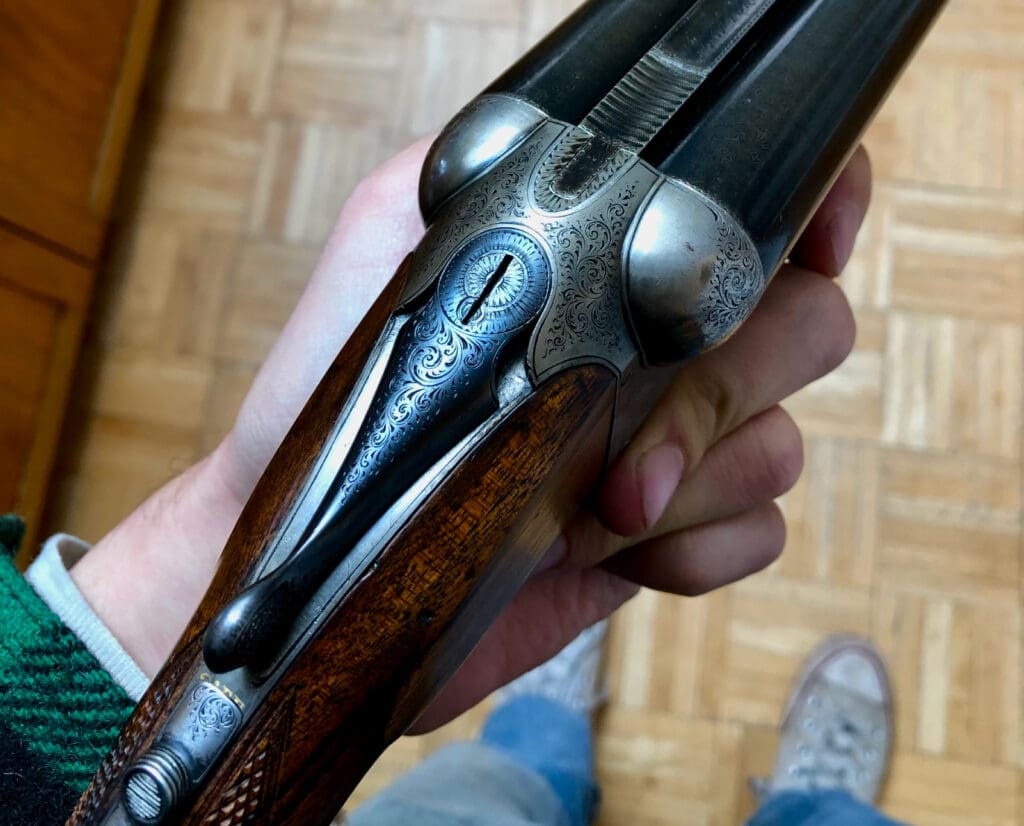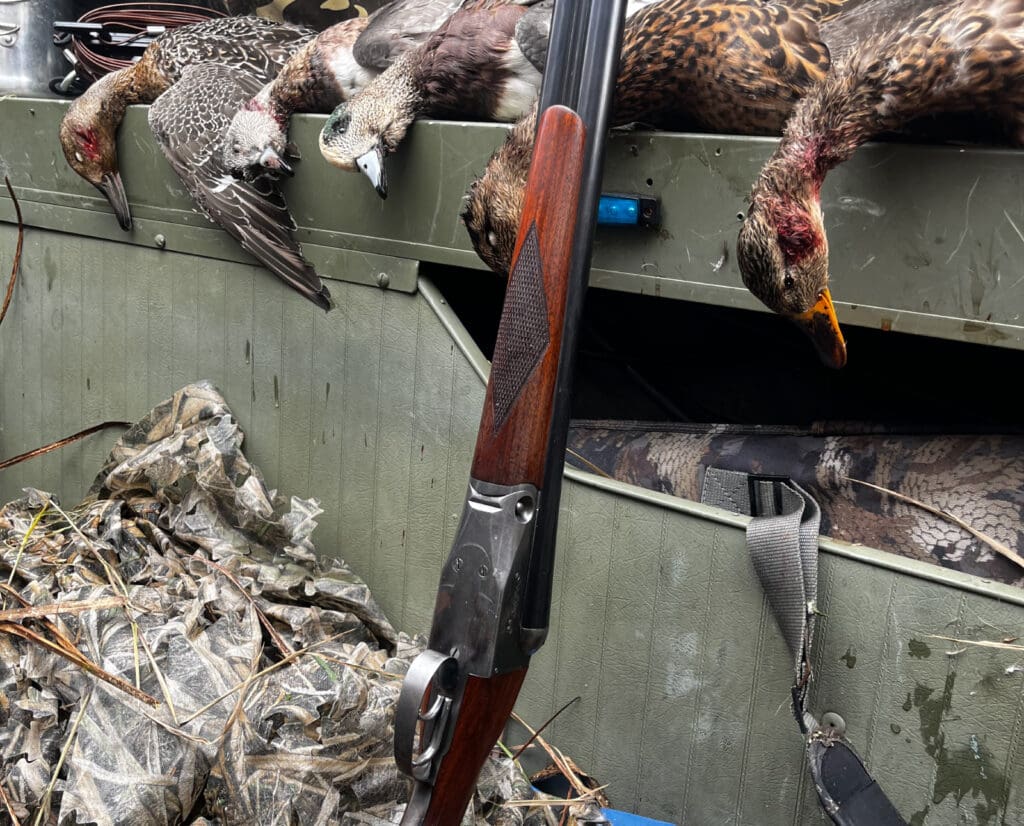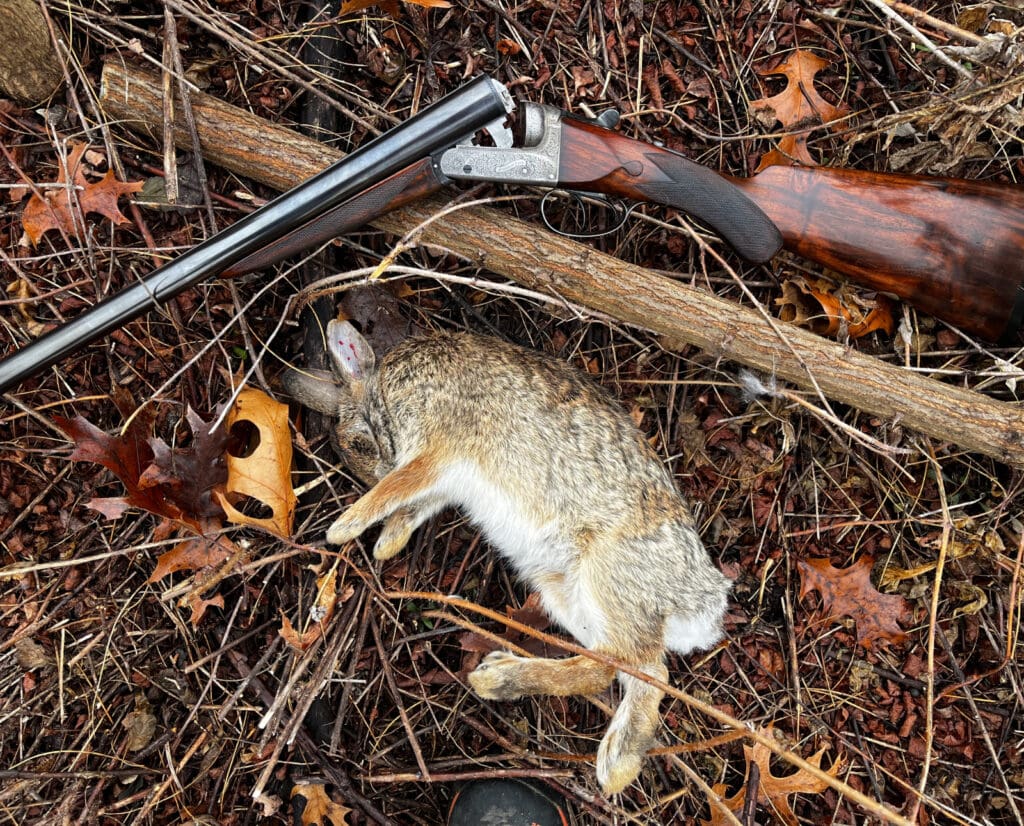Home » Firearms and Shooting » Shotguns » Why Hunt With a Vintage Shotgun?
Why Hunt With a Vintage Shotgun?

When he isn't in New York's Catskill Mountains, Matthew Every…
If you’re on the fence about taking an antique shotgun out bird hunting, here are a few reasons you should give it a try.
Being part of the hunting and shooting industry, I get to try the latest and greatest new guns every year. But when I’m not toting a gun for work, I’m usually carrying a vintage shotgun. My duck and pigeon gun turned 100 this year, and my grouse gun isn’t far behind it.
Listen to more articles on Apple | Google | Spotify | Audible
I have a safe full of old pumps, semi-autos, side-by-sides, and over-unders, and I’ll probably never get rid of them. Sure, I’m a sucker for patina, nice engraving, and all of the little things that make an old gun great. But what I love most about vintage shotguns is learning about where they came from, how they were made, and how they handle in the field.
A good vintage shotgun will serve you just as well, if not better, than a modern gun. It will do it all with style, and going vintage can save you a few bucks. If you aren’t convinced yet, here are a few more reasons why you should try hunting with a classic shotgun.
Sometimes, They’re Made Better Than Newer Guns
American gunmaking has always been about building the best guns for the best price, and today, we’re living in a golden age of cheap guns. You can find a new shotgun that’s capable of breaking as many clays and killing as many birds as you want for less than what you pay for groceries every month. To cut costs, though, manufacturers use fewer craftspeople and more machines than they once did. This is overall a good thing, as machines have gotten better and more precise. But something got lost along the way.
Back when craftsmanship and labor were cheap, a lot of handwork went into making a gun. You’ll pay a premium for things like hand engraving and hand checkering on a new gun today, but you can find comparable (and sometimes better) craftsmanship on vintage guns for a fraction of the price. Vintage guns were made with exceptional attention to detail, even under the hood. If you take apart a new over-under and an old over-under of similar quality, you may notice that the older one was finished better. Don’t get me wrong, they made crappy guns back then, too. But some classic guns have a level of quality you won’t find on a modern gun unless you’re willing to pay higher prices.

You Just Need to Know What You’re Buying
Some classic guns don’t work well anymore. Their stock dimensions are wonky, or the steel is too weak. But there are a lot of classic shotguns on the market today that work just fine. The best way to find good classic guns is to consult an established dealer who’s knowledgable on the subject. I buy guns from Safari Outfitters in Millbrook, New York, and I trust them to know what they’re talking about. I’d stay away from big box stores no matter how pretty their gun rooms look. Good gun dealers can tell you about things like wall thicknesses in barrels, provide choke measurements, and more about the history of a gun. They usually price guns accordingly and can work with you even if your budget is low.
My best advice to those who want to hunt with vintage shotguns—versus collecting them—is to start humble. Go for a vintage Auto 5 Sweet 16, an old Remington Model 31, or a Winchester Model 12. You can find them hanging around in many local gunshops around the country, and they are usually pretty affordable. Most vintage American guns were also built like tanks, and it’s easier to find replacement parts should you need them. All the while, educate yourself on historical shotgun makers and market values before making a big purchase and try to consult with someone who knows what they’re talking about before handing over your credit card. If you’re ever in doubt about the condition of a classic gun, bring in a gunsmith to look it over.

If You Plan to Hunt With the Shotgun, You Can Get a Good Deal
Gun collectors prize original condition above just about everything else. It’s rare to find vintage guns that haven’t been used in the field, and they command high prices. These are the kinds of prices that scare most hunters away from buying vintage shotguns and actually using them. But, if you plan to hunt with a classic and don’t care as much about the condition, you can find some good deals.
Refinished guns are of little value to the collector. Refinishing will actually devalue a gun (unless it was restored by a well-known specialist), but many are in good condition for hunting. The main thing to look out for on a refinished gun is barrel wall thickness. Every time a bore gets the pits polished out of it, it loses a little metal. Talk to a dealer or gunsmith and have the wall thicknesses measured.
You can also get a good deal on guns that have seen some time in the field. I recently bought a Parker that had a new recoil pad installed, and a slight blemish in the bluing from wear. It still locks up tight and shoots great, making it a perfect field gun. I’ve gotten burned like this, too, with a heavily used Browning Superposed. It had been shot a lot, and the rib eventually separated itself from the barrel after a long day of sporting clays. It still hits where I point it, so I take it out on rainy days when I leave my nicer guns at home. I also look at it as a small price to pay for a big education on buying old guns.
With guns that have some wear and tear, check to see how the action mates up to the barrels. If it’s tight, it probably wasn’t shot too much, or had some work done to it. Old pump shotguns should lock up tightly, too. Finally, you should measure chokes on a vintage gun before buying it, look for things like dents in the barrel, and test that the safeties still work.
Some Vintage Guns Handle and Shoot Better Than Modern Ones
I recently went to a grouse camp where everyone was carrying a subgauge shotgun. Americans tend to like subgauges because they’re light and trim, and we do a lot more walking than our European counterparts. It’s also because American guns tend to be overbuilt when compared to shotguns from across the Atlantic. Our answer to making a lightweight gun has been to make skinnier barrels and smaller actions. Just look at vintage Parkers.

European and English guns are different, though. The 1939 British 12-gauge I brought was just as light as the 20-gauges I hunted next to because it was made to be that way. One ounce of shot coming from my 12 gauge will pattern better than that same ounce coming from a 20 because it’s less constricted by bore diameter. I can also hunt grouse with 1-ounce target loads from just about any gun shop in the country instead of having to track down uncommon subgauge loads, like 28 gauge.
You could spend anywhere from $5,000 to $50,000 on a modern gun from overseas that would carry and shoot a lot like my vintage gun. Or you could buy a vintage 12-gauge like mine for less than $2,000 when you come across it.
Vintage Shotguns Have Style
I’m a big believer in the aesthetics of hunting. And before you accuse me of being a hipster hunter, consider this: hunting for sport is anything but practical. The vast majority of us are not subsistence hunters—especially upland bird hunters. You’d likely starve (or eat a lot more veggies) trying to bag enough birds to sustain you through a year. We hunt today to carry on traditions, connect with the natural world, take part in conservation, watch dogs work, and because it’s fun.
If hunting is supposed to be fun, then part of that fun for me is carrying a vintage shotgun, provided that I can use it as efficiently as a modern gun. Being able to use a tool that was made so well that it still works today is something I get a kick out of. And I spend a lot more time admiring my shotguns than I do actually shooting at birds. It’s like driving a vintage car or wearing a vintage watch. There’s an element of style with a classic gun that enriches the whole experience of hunting for me. I hope it does the same for you, too.
When he isn't in New York's Catskill Mountains, Matthew Every lives part-time on the highway in a 20-foot travel trailer with his wife and two dogs. He has hunted in three countries and 28 U.S. states. Before working independently as a writer, Every was a hunting guide in Idaho and Kentucky. He also served as an Associate Editor at Outdoor Life and Senior Editor at Field & Stream. Every currently writes for a number of hunting and fishing publications. He’s also an editor-at-large for F&S and loves hunting ruffed grouse, no matter how hard they are to find.




My pheasant and dove gun is an old Berretta SO3. It’s the nicest field gun I have ever shot. Double triggers which I like, straight stock which I like and it fits me. Someone put Briley chokes in it which are great but I would be happy if it were just improved cylinder and modified. In September I do change the chokes to skeet 1 and improved cylinder for doves but I could live with fixed chokes. It’s a beautiful gun. So beautiful that people comment on it. We have a big dove shoot here and all kinds of people come. Last year one guy asked me what the hell that gun was. I told him and handed it to him. He was amazed at how it handled and asked how much one would cost. I told him around $8K give or take. He handed it back and said he wished he hadn’t touched it! It comes to the shoulder without adjustment to shoot as a shotgun is supposed to do. Well, at least it does for me. They are custom-made. so the measurements vary.
One of the good things about being a bachelor I can spend my money on what I want. I am now buying an M2 carbine, i.e. a machine gun. Totally useless of course but fun. I can’t imagine too many wives would agree to such a purchase considering how expensive it is. I am lucky in that my girlfriend a few years ago bought me an original 1866 Winchester made in 1870. Quite a Christmas present.
I hunt with a Parker VH grade 12 gauge. It’s been restocked so I got a bit of a deal on it. But on the flip side it fits me fine. When I’m chasing pheasants in South Dakota or Chukar here on a preserve I love thinking of what it’s seen over 125 years. And the action is still tight as a tick’s &ss! Would’nt trade it for the world.